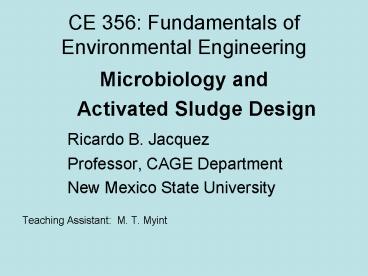CE 356: Fundamentals of Environmental Engineering - PowerPoint PPT Presentation
1 / 18
Title:
CE 356: Fundamentals of Environmental Engineering
Description:
Bacteria consume soluble (dissolved) BOD (organic substrate) and are ... (from Peavy, Rowe, and Tchobanoglous, 1985, p.231) Growth of. Heterotrophic Cultures ... – PowerPoint PPT presentation
Number of Views:80
Avg rating:3.0/5.0
Title: CE 356: Fundamentals of Environmental Engineering
1
CE 356 Fundamentals of Environmental Engineering
- Microbiology and
- Activated Sludge Design
- Ricardo B. Jacquez
- Professor, CAGE Department
- New Mexico State University
- Teaching Assistant M. T. Myint
2
Significant Microorganisms
- Bacteria single cell microorganisms that
reproduce by binary fission. - Fungi yeasts and molds.
- Protozoa Single cell animals
- Bacteria consume soluble (dissolved) BOD (organic
substrate) and are aggregated into biofilm and
floc to which suspended solids attach. - Plate biofilm
Activated sludge floc - bacterial
cells
3
(from Viessman, Jr. and Hammer, 1998, pp. 521-522)
4
Biomass General Formulas
- C60H87O23N12P
- C5H7O2N2
- C 50 How does this
- O 20 information relate
to - N 14 the
characteristics of - H 8 wastewater?
- P 3
- Total 95
5
Growth ofHeterotrophic Cultures
- Cultures
- - Continuous Growth substrate (BOD) fed
continuously - - Batch Growth
- Single dose of substrate (BOD)
- Single inoculation of biomass (mixed liquor
suspended solids, MLSS) - Growth not limited by O2, N, or P
- Monitor change of substrate level (COD or BOD)
and MLSS with time
6
(from Peavy, Rowe, and Tchobanoglous, 1985, p.231)
7
Growth ofHeterotrophic Cultures
- Lag phase acclimation to new substrate, could
be short lived - Log Growth active reproduction by binary
fission - Stationary Growth Death
- Endogenous Death gt Growth
- In lag and log growth phases sufficient substrate
is available - In stationary and endogenous phases substrate is
limited
8
Design Equation Identify, define (units), and
describe the design parameters vs typical
known conditions. Which parameter(s) does the
design engineer control?
9
Sludge Age
- Sludge age is the length of time (days) the
sludge (bacteria) is retained within the
secondary treatment process. - Activated sludge 10 days Ynet 0.4 - 0.6
- Trickling filter 100 days Ynet 0.1
- 0.3 - Trickling filters also produce a more dense
(thicker) sludge - TF 1.5 solids
- AS 0.8 solids
10
Activated Sludge
- Definition A process in which wastewater
continuously flows into an aerated tank in which
a culture of suspended microorganisms
biologically flocculate and metabolize colloidal
and soluble organic material (BOD). - Primary organisms bacteria, consume soluble and
colloidal organics. - Secondary organisms protozoa, consume suspended
organics and dispersed bacteria. - Aeration provides
- Mixing necessary to keep microorganisms in
contact with the organics. - Oxygen for metabolism.
11
Biological Principles
- Primary
- Treated Aeration Secondary
Effluent - Wastewater Tank Clarifier
- Recycled Sludge
-
Waste Sludge - Aeration Tank the content of the aeration tank
is referred to as the mixed liquor. In the
aeration tank, the microorganisms come in contact
with the waste material. As the organic material
is being decomposed synthesis of the
microorganisms occurs.
12
Biological Principles
- Secondary Clarifier mixed liquor is allowed to
separate, the supernatant becomes the effluent. - Wasted Sludge sludge must be wasted to prevent
excessive buildup of the microorganisms
decreasing the F/M. - Recycled Sludge sludge is recycled to maintain
the F/M ratio. If the sludge is not recycled the
microorganism concentration will be diluted.
13
Design andOperational Parameter
- Food to Microorganism Ratio (F/M)
- Common range for F/M ratio 0.05 to 0.6 day-1
(0.05 for extended aeration, 1.0 for pure oxygen)
14
- Example Determine the F/M ratio for an
activated sludge process operating under the
following conditions BOD 200 mg/L, Q 1MGD,
td 4 hrs (0.167day), MLVSS 2,550 mg/L - MBOD 1 MGD x 200 mg/L x 8.34 lb/(MG-mg/L)
- MBOD 1,668 lbs/day
- V Q x td 1 MGD x 0.167 day 0.167 MG
- Msludge 0.167 MG x 2,550 mg/L x 8.34
lb/(MG-mg/L) - Msludge 3,552 lbs (in aeration tank)
- F/M 1,669 lbs/day / 3,552 lbs 0.47 day-1
15
(from Reynolds/ Richards, 1996)
16
Conventional Treatment
- Inf. H2O
- S.C.
Eff. H2O - F /M 0.2 to 0.4 -
- MLSS 1,500 to
3,000 mg/L - Aeration Waste
Sludge - td 4 to 8 hrs - Recycle Sludge
- F/M is decreasing across -
the length of
the tank. -
- O2 Supply
S.C. secondary clarifier - O2
- O2 Demand
- Tank Length
17
Completely Mixed
- Inf. Recycle
Sludge Waste Sludge - H2O
-
S.C. Eff. H2O - Aeration
-
- F/M 0.2 to 0.6 -
- MLSS 3,000 6,000 mg/L - O2 supply -
td 3 5 hrs - O2
- O2 demand
- Tank Length
18
Example for Review
- See pgs 576 577
- Example 12.9































